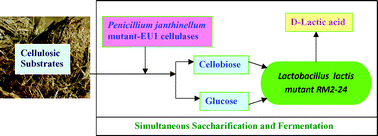d-(−)-Lactic acid production from cellobiose and cellulose by Lactobacillus lactis mutant RM2-2†4
Abstract
Lactobacillus lactis mutant RM2-24 utilizes

* Corresponding authors
a
NCIM Resource Center, National Chemical laboratory, Dr Homi Bhabha Road, Pune, India
E-mail:
dv.gokhale@ncl.res.in
Fax: 91-20-25902671
Tel: 91-20-25902670
b Polymer Science and Engineering, National Chemical laboratory, Pune, India
Lactobacillus lactis mutant RM2-24 utilizes

 Please wait while we load your content...
Something went wrong. Try again?
Please wait while we load your content...
Something went wrong. Try again?
M. Singhvi, D. Joshi, M. Adsul, A. Varma and D. Gokhale, Green Chem., 2010, 12, 1106 DOI: 10.1039/B925975A
To request permission to reproduce material from this article, please go to the Copyright Clearance Center request page.
If you are an author contributing to an RSC publication, you do not need to request permission provided correct acknowledgement is given.
If you are the author of this article, you do not need to request permission to reproduce figures and diagrams provided correct acknowledgement is given. If you want to reproduce the whole article in a third-party publication (excluding your thesis/dissertation for which permission is not required) please go to the Copyright Clearance Center request page.
Read more about how to correctly acknowledge RSC content.
 Fetching data from CrossRef.
Fetching data from CrossRef.
This may take some time to load.
Loading related content
